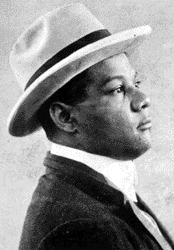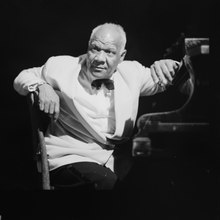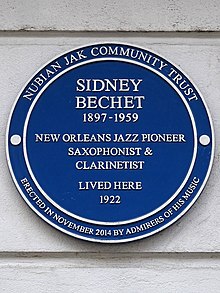User:Juliewagoner12/Sidney Bechet
Edits that I had published to the Wikipedia page before utilizing my sandbox:
- Added the list of references at the bottom of this page
- Created several sub-headings (Musical Development, Bechet in France, Later Life, Permanent Settlement in Paris, Autobiography & Death) because previously all of this information had been put in one section.
- Rearranged information in the article body to make it more succinct.
- Added citations to pieces of information that lacked references.
- Created the "albums" sub-heading and added a list of Bechet's albums
- Created the "movies" sub-heading and rerouted that information from the "Later Life" section
- Added an image of a soprano saxophone
- Added to the "Singles" section
- Added to the list of "external links"
| This is the sandbox page where you will draft your initial Wikipedia contribution.
If you're starting a new article, you can develop it here until it's ready to go live. If you're working on improvements to an existing article, copy only one section at a time of the article to this sandbox to work on, and be sure to use an edit summary linking to the article you copied from. Do not copy over the entire article. You can find additional instructions here. Remember to save your work regularly using the "Publish page" button. (It just means 'save'; it will still be in the sandbox.) You can add bold formatting to your additions to differentiate them from existing content. |
Article Draft[edit]
Lead[edit]
Sidney Joseph Bechet[1] (May 14, 1897 – May 14, 1959) was an American jazz saxophonist, clarinetist, and composer. He was one of the first important soloists in jazz, and first recorded several months before trumpeter Louis Armstrong.[2] His erratic temperament hampered his career, and not until the late 1940s did he earn wide acclaim. Bechet spent much of his later life in France.[3]
Article body[edit]
Early Life[edit]
Bechet was born in New Orleans in 1897 to a middle-class Creole of color family. Bechet's father Omar was both a shoemaker and a flute player, and all four of his brothers were musicians as well.[4] His older brother, Leonard Victor Bechet, was a full-time dentist and a part-time trombonist and bandleader. Bechet learned and mastered several musical instruments that were kept around the house (he began on the cornet), mostly by teaching himself; he decided to specialize in the clarinet (which he played almost exclusively until about 1919).[4] At the age of six, he started to perform with his brother's band at a family birthday party, debuting his talents to acclaim. Later in his youth, Bechet studied with Joseph "King" Oliver, Bunk Johnson, Freddie Keppard[3], Lorenzo Tio, "Big Eye" Louis Nelson Delisle, and George Baquet.[5]
Musical Development[edit]
Bechet played in many New Orleans ensembles using the improvisational techniques of the time (obbligatos with scales and arpeggios and varying the melody). While working with Louis Armstrong, Bechet was the first musician to develop the Swing style of jazz, and influence the widening difference between jazz and ragtime.[3] Bechet liked to have his sound dominate in a performance, and trumpeters found it difficult to play alongside him.[6][7] He performed in parades with Freddie Keppard's brass band, the Olympia Orchestra, and in John Robichaux's dance orchestra. From 1911 to 1912, he performed with Bunk Johnson in the Eagle Band of New Orleans and in 1913–14 with King Oliver in the Olympia Band. From 1914 to 1917, he was touring and traveling, going as far north as Chicago and frequently performing with Freddie Keppard. In the spring of 1919, he traveled to New York City where he joined Will Marion Cook's Syncopated Orchestra. Soon after, the orchestra traveled to Europe; almost immediately upon arrival, they performed at the Royal Philharmonic Hall in London. The group was warmly received, and Bechet was especially popular.[5] While in London, he discovered the straight soprano saxophone and developed a style unlike his clarinet tone. Bechet was the first influential soprano saxophonist, and led to its rising popularity in jazz.[4] His saxophone sound could be described as emotional, reckless, and large. He often used a broad vibrato, similar to some New Orleans clarinetists at the time. In 1919, Ernest Ansermet, a Swiss classical music conductor, wrote a tribute to Bechet, one of the earliest (if not the first) to a jazz musician from the field of classical music, linking Bechet's music with that of Bach.[5] Bechet's first recordings were made in 1923 and 1924[3]. The session was led by Clarence Williams, a pianist and songwriter, better known at that time for his music publishing and record producing, and his "Blue Five" (which included Louis Armstrong)[3]. Bechet recorded "Wild Cat Blues" and "Kansas City Man Blues". "Wild Cat Blues" is in a ragtime style with four 16-bar themes, and "Kansas City Man Blues" is a 12-bar blues.[4] In 1924, Bechet worked with Duke Ellington for three months and made a significant impact on Ellington's early jazz style.[3] Duke Ellington also called him "the epitome of jazz."[8]

Bechet in France[edit]

On September 15, 1925, Bechet and other members of the Revue Nègre, including Josephine Baker, sailed to Europe, arriving at Cherbourg, France, on September 22. The revue opened at the Théâtre des Champs-Élysées[9] in Paris on October 2. The show was an example of negrophilia in France at the time.[10] He toured Europe with multiple bands, reaching as far as Russia in mid-1926. In 1928, he led his small band at Chez Bricktop (run by the popular Ada "Bricktop" Smith) in Montmartre, Paris.
He was imprisoned in Paris for eleven months.[11][12] In his autobiography, he wrote that he accidentally shot a woman when he was trying to shoot a musician who had insulted him. He had challenged the man to duel and said, "Sidney Bechet never plays the wrong chord."[13] After his release, he was deported to New York, arriving soon after the stock market crash of 1929. He joined with Lorenzo Tio and also came to know trumpeter Roy Eldridge.[6]
In 1932, Bechet returned to New York City to lead a band with Tommy Ladnier. The band, consisting of six members, performed at the Savoy Ballroom. He played in Noble Sissle's orchestra, which toured in Germany and Russia.
Later Life[edit]
In 1938, "Hold Tight, Hold Tight (Want Some Seafood Mama)", commonly known as "Hold Tight", was composed by Bechet's guitarist Leonard Ware and two session singers with claimed contributions from Bechet himself. The song became known for its suggestive lyrics and then for a series of lawsuits over songwriter royalties.
In 1939, Bechet and the pianist Willie "The Lion" Smith led a group that recorded several early versions of what was later called Latin jazz, adapting traditional méringue, rhumba and Haitian songs to the jazz idiom. On July 28, 1940, Bechet made a guest appearance on the NBC Radio show The Chamber Music Society of Lower Basin Street, playing two of his showpieces ("Shake It and Break It" and "St. Louis Blues") with Henry Levine's Dixieland band. Levine invited Bechet into the RCA Victor recording studio (on 24th Street in New York City), where Bechet lent his soprano sax to Levine's traditional arrangement of "Muskrat Ramble". On April 18, 1941, as an early experiment in overdubbing at Victor, Bechet recorded a version of the pop song "The Sheik of Araby", playing six different instruments: clarinet, soprano saxophone, tenor saxophone, piano, bass, and drums. A hitherto unissued master of this recording was included in the 1965 LP Bechet of New Orleans, issued by RCA Victor as LPV-510. In the liner notes, George Hoeffer quoted Bechet:
"I started by playing The Sheik on piano, and played the drums while listening to the piano. I meant to play all the rhythm instruments, but got all mixed up and grabbed my soprano, then the bass, then the tenor saxophone, and finally finished up with the clarinet."
In 1944, 1946, and 1953, he recorded and performed in concert with the Chicago jazz pianist and vibraphonist Max Miller; private recordings from Miller's archive have never been released. These concerts and recordings are described in John Chilton's biography Sidney Bechet: The Wizard of Jazz.[14]
With jobs in music difficult to find, he opened a tailor shop with Ladnier. They were visited by musicians and played in the back of the shop. In the 1940s, Bechet played in several bands, but his financial situation did not improve until the end of that decade. By the end of the 1940s, Bechet had tired of struggling to make music in the United States. His contract with Jazz Limited, a Chicago-based record label, was limiting the events at which he could perform (for instance, the label would not permit him to perform at the 1948 Festival of Europe in Nice). He believed that the jazz scene in the United States had little left to offer him and was getting stale.[6]
Permanent Settlement in Paris[edit]
In 1951, he migrated to France permanently[3], after his performance as a soloist at the Paris Jazz Fair caused a surge in his popularity in that country, where he easily found well-paid work. Also in 1951, he married Elisabeth Ziegler in Antibes.

In 1953, he signed a recording contract with Disques Vogue that lasted for the rest of his life.[6] He recorded many hit tunes, including "Les Oignons", "Promenade aux Champs-Elysees", and the international hit "Petite Fleur". He also composed a classical ballet score in the late Romantic style of Tchaikovsky called La Nuit est une sorcière ("The Night Is a Witch"). Some existentialists in France took to calling him le dieu ("the god").[15]
Autobiography & Death[edit]
Shortly before his death, Bechet dictated his autobiography, Treat It Gentle, to Al Rose, a record producer and radio host. He had worked with Rose several times in concert promotions and had a fractious relationship with him. Bechet's view of himself in his autobiography was starkly different from the one Rose knew.
"The kindly old gentleman in his book was filled with charity and compassion. The one I knew was self-centered, cold, and capable of the most atrocious cruelty, especially toward women."[16]
Although embellished and frequently inaccurate, Treat It Gentle remains a staple account for the "insider's view of the New Orleans tradition."[17]
Bechet died in Garches, near Paris, of lung cancer on May 14, 1959 on his 62nd birthday. He is buried in a local cemetery.[18] Several other major jazz musicians died this year as well: Billie Holiday and Lester Young.[8]
Personal life[edit]
Bechet was known for having an abrasive attitude, which has been compared to that of Coleman Hawkins.[20] They were both incredibly sure of their relative importance in the music industry during a time in which jazz was losing popularity. They were stubborn and lacked patience for younger artists who had less experience or knowledge about the jazz industry.[20]
Awards[edit]
- DownBeat magazine Hall of Fame, 1968[21]
- Awarded a blue plaque outside his former London home, 2014 (pictured).[22]

Discography[edit]
Singles[edit]
- "Texas Moaner Blues", with Louis Armstrong, 1924
- "Cake Walkin' Babies from Home", with Red Onion Jazz Babies, 1925
- "Got the Bench, Got the Park (But I Haven't Got You)", 1930
- "Blues in Thirds", 1940
- "Dear Old Southland", 1940
- "Egyptian Fantasy", 1941
- "Muskrat Ramble", 1944
- "Blue Horizon", 1944
- "Dutch Swing College Blues", 1954[23]
- "Kansas City Man Blues", 1954[23]
- "Petite Fleur", 1959
- "Dans les Rues D'Antibes", 1960[23]
- "Premier Bal", 1960[23]
- "Who's Sorry Now", 1961[23]
- "Weary Blues", 1979[23]
Albums[edit]
- "A Jazz Masterwork", 1948[23]
- "Sidney Bechet & Claude Luter", 1950[24]
- "Jazz Classics Vol. 1", 1950[24]
- "Jazz Classics Vol. 2", 1950[24]
- "Sidney Bechet - Bunk Johnson: Days Beyond Recall", 1951[24]
- "Sidney Bechet, Claude Luter: On Parade", 1951[24]
- "Sidney Bechet, Claude Luter, Andre Reweliotty et son Orchestre: Bechet-Souvenirs", 1951[24]
- "Sidney Bechet, Muggsy Spanier: Jam Session", 1952[24]
- "Sidney Bechet", 1952[24]
- "Port of Harlem Six", 1952[24]
- "Soprano Sax Solos", 1952[24]
- "French Movies", 2014[24]

November, 1947--Bill Reinhardt (clarinet), Danny Alvin (drums), Sidney Bechet (soprano sax), Mel Grant (piano), and Munn Ware (trombone).

Movies[edit]
Bechet was featured in three films and played a jazz musician.
- Série noire,[25]
- L'inspecteur connaît la musique,[26]
- Quelle équipe![26]
Media to Add:[edit]



References[edit]
References added to the page by me:
- https://www.imdb.com/name/nm0065000/
- http://www.culturalequity.org/alan-lomax/friends/bechet
- https://www.blackpast.org/african-american-history/bechet-sidney-1897-1959/
- https://musicalgeography.org/project/the-travels-of-josephine-baker-and-sidney-bechet/
- https://www.discogs.com/artist/258422-Sidney-Bechet
- http://www.jazzmusicarchives.com/artist/sidney-bechet
- https://www.jstor.org/stable/41201416?seq=1#metadata_info_tab_contents (peer reviewed)
- https://www.jstor.org/stable/3051437 (peer reviewed)
- https://www.radioswissjazz.ch/en/music-database/musician/1765910c3914739fd5eb94e2cfcaf03cda105/biography
- ^ "Sidney Joseph Bechet". Findagrave.com.
- ^ Yanow, Scott. "Sidney Bechet". AllMusic.com. Retrieved 2011-06-28.
- ^ a b c d e f g Hudson, Rob (2008-01-14). "Sidney Bechet (1897-1959) •". Retrieved 2021-11-12.
- ^ a b c d "Sidney Bechet | Association for Cultural Equity". The Association for Cultural Equity. Retrieved 2021-11-12.
- ^ a b c Porter, Lewis; Ullman, Michael (1988). "Sidney Bechet and His Long Song". The Black Perspective in Music. 16 (2): 135–150. doi:10.2307/1214805. JSTOR 1214805.
- ^ a b c d Horricks, Raymond (1991). Profiles in Jazz. New Brunswick, New Jersey: Transaction. pp. 1–10. ISBN 9780887384325.
- ^ Yanow, Scott. "Sidney Bechet". AllMusic.com. Retrieved 2011-06-28.
- ^ a b YUDKIN, JEREMY (2010). "Review of Sidney Bechet: Treat It Gentle; The Life and Times of a Jazz Master". Yearbook for Traditional Music. 42: 237–238. ISSN 0740-1558.
- ^ Shack, William A. (2001). Harlem in Montmartre. Berkeley: University of California Press. p. 35. ISBN 0-520-22537-6.
- ^ "The Travels of Josephine Baker and Sidney Bechet | Musical Geography". Retrieved 2021-11-17.
- ^ Cohassey, John. "Sidney Bechet". www.encyclopedia.com. Retrieved 10 September 2018.
- ^ Palmer, Robert (1976). Sidney Bechet: Master Musician (Media notes). Bluebird Records.
- ^ "The struggle in Paris". My Life - Sidney Bechet. Retrieved 10 September 2018.
- ^ Chilton, John (1987). Sidney Bechet: The Wizard of Jazz. Macmillan. ISBN 0333443861.
- ^ Filan, Kenaz (2011). "Appendix 2". The New Orleans Voodoo Handbook. Rochester, Vermont: Destiny Books. ISBN 978-1594774355.
- ^ Rose, Al (1987). I Remember Jazz: Six Decades Among the Great Jazzmen. Baton Rouge: Louisiana State University Press. pp. 60–65. ISBN 0-8071-2571-7.
- ^ Stephen Cottrell (2013). The Saxophone (Yale Musical Instrument Series). Yale Musical Instrument Series. p. 187.
- ^ "Sidney Joseph Bechet". Findagrave.com.
- ^ Hill, Gary (2007-04-30). "Historic jazz church in New Orleans clings to life". Reuters. Retrieved 2020-12-03.
- ^ a b Tucker, Mark (1991). "Review of Sidney Bechet: The Wizard of Jazz; The Song of the Hawk: The Life and Recordings of Coleman Hawkins, John Chilton". American Music. 9 (3): 320–325. doi:10.2307/3051437. ISSN 0734-4392.
- ^ "Radio Swiss Jazz - Music database - Musician". Retrieved 2021-11-23.
- ^ "Sidney Bechet awarded blue plaque". www.telegraph.co.uk. Retrieved 2021-11-23.
- ^ a b c d e f g "Sidney Bechet". Discogs. Retrieved 2021-11-17.
- ^ a b c d e f g h i j k "SIDNEY BECHET". JazzMusicArchives.com. Retrieved 2021-11-17.
- ^ "Série noire". Allocine.fr. Retrieved 2015-12-30.
- ^ a b "Ah, quelle équipe!". Allocine.com. Retrieved 2015-12-30.

